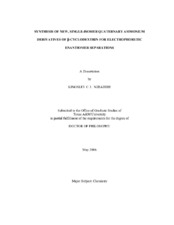| dc.description.abstract | The isolation of individual enantiomers of drugs is an important subject of
interest in the pharmaceutical and medical fields, because stereochemistry can have a
significant effect on the biological activity of the drug. Therefore, it is important to
develop enantiomeric separation methods for the determination of the optical purity of
drugs, since the undesired enantiomer is regarded as one of the impurities.
The available single isomer anionic cyclodextrins (CD) can resolve the
enantiomers of only a few weakly acidic analytes. To rectify this problem, the chloride
salts of heptakis(6-deoxy-6-morpholinio)-cyclomaltoheptaose (HMBCD), and mono(6-
deoxy-6-N,N,N r,N r,N r-pentamethylethylenediammonio)-cyclomaltoheptaose
(PEMEDA-BCD), the first members of the permanently charged, single-isomer cationic
cyclodextrin family, have been synthesized. The purity of process intermediates and
final products was determined by HPLC-ELSD and indirect UV-detection capillary
electrophoresis. Structural identity was verified by 1D and 2D NMR and massBoth cationic CD derivatives have been used for the separation of the
enantiomers of strong acid, weak acid, weak base, ampholytic, and neutral analytes by
capillary electrophoresis. Because the charge state of these cationic chiral resolving
agents is independent of the pH of the buffer, separation could be performed in both low
and high pH buffers without compromising the charge density of the resolving agent.
Contrary to expectation, the multiply charged HMBCD showed poor complexation with
the newly synthesized strong electrolyte test analytes. The weak binding between the
analytes and HMBCD resulted in separation of enantiomers of only three strong
electrolyte analytes. Strong complexation was observed between PEMEDA-BCD and
the anionic and nonionic analytes in both low and high pH buffers, though complexation
was stronger in the high pH buffer. Due to strong complexation between the anions and
PEMEDA-BCD, only low concentrations of the resolving agent were required to effect
good enantiomer resolutions.
spectrometry. | en |


